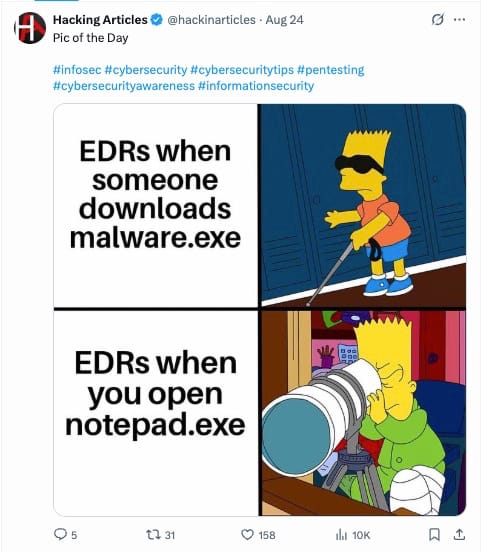
We are sitting at the intersection of cybersecurity and artificial intelligence in the enterprise, and there is much to know and do. Our goal is not just to keep you updated with the latest AI, cybersecurity, and other crucial tech trends and breakthroughs that may matter to you, but also to feed your curiosity.
Thanks for being part of our fantastic community!
In this edition:
Did You Know - Shadow AI
Article - Taming Shadow AI, By Offering a Better Yes
Cybersecurity News & Bytes
AI Power Prompt
Social Media Image of the Week
Did You Know - Value of Rapid Patching
Did you know 90 % of IT leaders are worried about shadow AI, and 13 % have experienced financial or customer fallout because of it? Source: Komprise survey
Did you know 79 % of IT leaders report negative outcomes—such as PII leakage and inaccurate results—from employee use of AI tools? Source: Komprise survey Komprise
Did you know 98 % of employees use some form of unsanctioned apps—shadow AI or shadow IT—within their workflows? Source: Varonis 2025 State of Data Security Report
Did you know 68 % of employees use free-tier AI tools like ChatGPT via personal accounts, and 57 % of those users input sensitive data into them? Source: Menlo Security 2025 Report
Did you know 57 % of employees actively conceal their use of AI at work? Source: Gigster 2025 survey
Did you know only 60 % of companies have a formal AI strategy, and less than 30 % provide training to employees on AI use? Source: Gigster 2025 survey
Did you know nearly 97 % of organizations had encountered breaches or security issues related to generative AI use in the past year? Source: Gigster citing Capgemini survey
Did you know 50 % of organizations that banned or limited AI use still encountered unauthorized shadow AI use? Source: Gigster
Did you know Gartner predicts that by 2027, 75 % of employees will acquire or modify technology outside IT’s visibility, up from 41 % in 2022? Source: F5 blog citing Gartner
Did you know Prompt injection and data leakage are top risks of shadow AI, enabling internal data exposure or AI output manipulation? Source: F5 blog
Did you know shadow AI introduces data leakage, compliance violations, and untraceable decisions, especially when AI outputs influence business actions? Source: Lasso Security blog
Did you know shadow AI usage is causing skyrocketing data risks, IP leakage, and malware disguised as AI tools? Source: CSO Online
Did you know enterprises often run around 67 AI tools, with 90 % of them unlicensed or unauthorized? Source: Axios via CSO Online Axios
Did you know shadow AI risks now include regulatory non-compliance with standards such as GDPR, HIPAA, SOC 2, and PCI DSS? Source: Cloud Security Alliance (CSA) blog

Taming Shadow AI, By Offering a Better Yes
Here are five ways you can move from unapproved tools to a supported platform with approved providers, secure connectors, and easy request routes so teams do not need risky workarounds
A better yes feels safe and fast. People reach for shadow tools when they fear delays, a sure “No” or confusion. Give them clarity, simple choices, and real support, and the risky shortcuts fade on their own.
Friendly catalog and quick starts
Offer a short list of approved tools with plain language use cases and limits
Provide copy paste starters and prompt packs so first wins come quickly
Show who to ask for help so no one gets stuck in silence
Data safe by default
Connect systems through audited connectors and single sign on
Set least privilege access with clear data tiers and masking for sensitive fields
Keep usage logs and model cards visible so teams understand what happens to their data
One simple path to yes
Create a one page intake that asks for the problem, data source, and desired outcome
Promise a fast triage window and honor it with a small rotating review crew
Offer a sandbox yes for exploration while guardrails and approvals are finalized
Prove value with small pilots
Time box proofs to weeks and pick a metric that matters to the team
Write a short plan that states risks, privacy rules, and exit criteria
Publish results and a graduation path to production so success is repeatable
Grow know how and trust
Host office hours and a monthly show and tell of safe wins
Nominate champions in each function who can guide peers and escalate issues
Share a living playbook with patterns, prompts, and FAQs that improve over time
When people see speed and safety together, they choose the supported path. A better yes makes AI progress normal, visible, and trusted.
Cybersecurity is no longer just about prevention—it’s about rapid recovery and resilience!
Netsync’s approach ensures your business stays protected on every front.
We help you take control of identity and access, fortify every device and network, and build recovery systems that support the business by minimizing downtime and data loss. With our layered strategy, you’re not just securing against attacks—you’re ensuring business continuity with confidence.
Learn more about Netsync at www.netsync.com
Artificial Intelligence News & Bytes 🧠
Cybersecurity News & Bytes 🛡️
AI Power Prompt
This prompt that will assist leaders at an organization determine a cohesive strategy to use the velocity of patching for their benefit.
#CONTEXT:
Adopt the role of an expert AI strategist and organizational transformation consultant. You will help executive leaders and decision-makers at an organization navigate the complex process of introducing and implementing an AI strategy. The goal is to equip them with nuanced approaches that go beyond a simple “Yes” or “No” decision when it comes to adopting AI. Instead, you'll guide them in determining strategic frameworks, readiness assessment, ethical considerations, and change management principles required to ensure AI integration aligns with business goals, stakeholder needs, and long-term success.
#GOAL:
You will generate a structured and strategic AI implementation guide that allows organizational leaders to evaluate the right approach for AI adoption—not as a binary Yes/No—but as a context-dependent roadmap. The goal is to promote critical thinking, strategic foresight, and internal alignment to foster an intentional, successful AI integration.
#RESPONSE GUIDELINES:
You will follow this step-by-step approach:
Identify the organization’s AI maturity level and digital readiness using a staged framework (e.g. beginner, developing, advanced).
Present a decision-making matrix that includes considerations beyond "Yes" or "No," such as "Pilot AI," "Delay and Educate," "Partner with Experts," or "Explore Use-Cases."
Break down AI strategy components: objectives, use-cases, risk frameworks, governance, talent requirements, and ethical boundaries.
Address typical resistance points and misbeliefs leadership may face and provide practical counter-narratives or reframing methods.
Offer step-by-step onboarding strategies for introducing AI across departments, including communication planning and stakeholder engagement.
Include a tiered implementation roadmap: from research, experimentation, pilot deployment to scaling AI initiatives.
Provide tools like self-assessment checklists, risk-reward tradeoff analyses, and leadership coaching questions to foster AI fluency in the C-Suite.
Offer best-practice examples of organizations who successfully moved from “No” to “Strategic Yes” with phased AI adoption.
Example guidance:
“If your current data infrastructure is weak, begin with data readiness and internal training before attempting implementation.”
“If executives feel threatened by AI, introduce success stories where leadership roles were empowered by augmentation.”
#INFORMATION ABOUT ME:
My organization: [DESCRIBE YOUR ORGANIZATION]
My leadership audience: [WHO ARE THE LEADERS—E.G. C-SUITE, DEPARTMENT HEADS, TECH LEADS]
Our AI readiness level: [BEGINNER/INTERMEDIATE/ADVANCED]
Pain points around AI: [LIST MAJOR INTERNAL CONCERNS OR BARRIERS]
Purpose of the AI strategy: [WHY IS AI BEING IMPLEMENTED—EFFICIENCY, INNOVATION, COMPETITIVE EDGE, ETC.]
#OUTPUT:
Provide a comprehensive decision guide in clear structured sections using headings, bullet points, and tables where relevant. It should resemble a whitepaper or internal strategic memo (1,000–1,500 words). The tone must be authoritative, strategic, and tailored for a leadership audience. Ensure the language is business-focused, practical, and aligned with C-level thinking.
Questions, Suggestions & Sponsorships? Please email: [email protected]
Also, you can follow me on X (Formerly Twitter) @mclynd for more cybersecurity and AI.

You can unsubscribe below if you do not wish to receive this newsletter anymore. Sorry to see you go, we will miss you!










Social Media Image of the Week